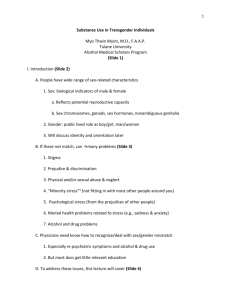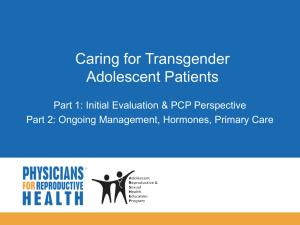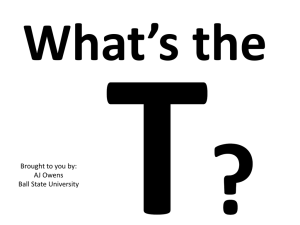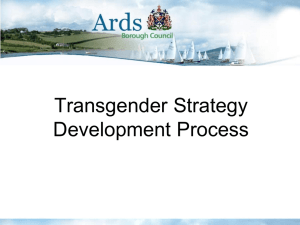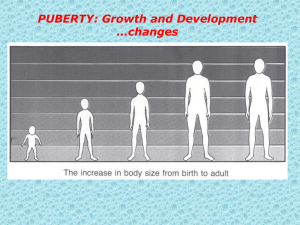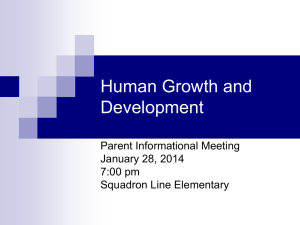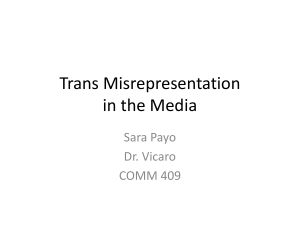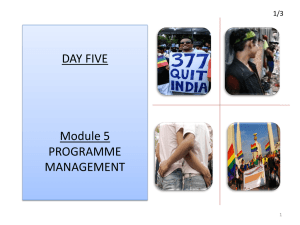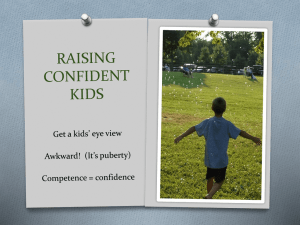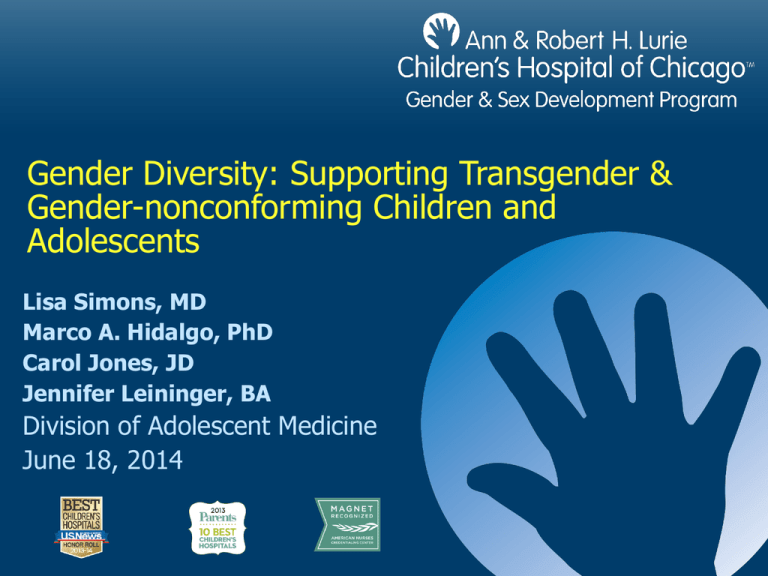
Gender Diversity: Supporting Transgender &
Gender-nonconforming Children and
Adolescents
Lisa Simons, MD
Marco A. Hidalgo, PhD
Carol Jones, JD
Jennifer Leininger, BA
Division of Adolescent Medicine
June 18, 2014
Disclosures
• We have no relevant financial relationship with the
manufacturer(s) of any commercial product(s) and/or
provider of commercial products or services discussed today
• Medical treatments discussed in this presentation are all offlabel
• Treatment recommendations are based on best available
evidence
2
Learning Objectives
• Learn (or re-familiarize yourself with) key terminology related
to gender and sexuality
• Learn about development trajectories of gendernonconformity and transgenderism in children and
adolescents
• Learn about approaches to assessment and care of gendernonconforming and transgender youth
• Learn “What We Don’t Yet Know” about the healthy
development of gender-nonconforming/transgender youth
3
Overview and Schedule of
Training
• Key Terminology related to Gender Development
• Gender Development in Gender-nonconforming and
Transgender Youth
• Behavioral Health and Medical Care
• Description of Lurie Children’s Gender Development Program
• Q&A
4
Key Terminology
related to
Gender Development
5
Key Terminology
• Sex (Biological construct)
– Attributes that characterize biological maleness and femaleness:
• Sex-determining genes, chromosomes
• Hormones
• Reproductive anatomy (internal/external genitalia)
– Determines birth-assigned male or female gender (i.e., “natal gender”)
• Gender (Social construct)
– “The attitudes, feelings, and behaviors that a given culture associates
with a person’s biological sex.” (APA, 2011)
• “A person’s self concept of their gender (regardless of their biological
sex)…” (Lev, 2004)
6
Key Terminology (continued)
• Gender Identity refers to
– An individual’s personal sense of self as male, female, or an alternate
gender
– Psychologically rooted, and internally determined
– Most children have a strong sense between ages 4-6
• Gender Expression refers to
– How gender identity is externalized and communicated to others
• e.g., one’s name, gender pronoun, style of dress, interests, etc.
– Begins around ages 2-3 years
– Conformity: masculinity in natal males, femininity in natal females
– Expectations vary across cultures and over time
• e.g., men in kilts, waist wraps, women wearing pants, boys wearing
dresses
7
Key Terminology (continued)
• Gender Nonconformity (or Gender Variance) refers to
– Gender expressions, identity and behaviors that fall outside the norm for
one’s natal gender
– May (or may not) include a change in gender identity
• Natal male: “I am a boy and I like to express femininity.”
versus
• Natal male: “I am a girl and I like to express femininity.”
– Long-standing occurrence (e.g., 6 mos or more) – not a fleeting
curiosity or interest
8
Key Terminology (continued)
• Sexual Orientation refers to
– The gender to which one is romantically and/or sexually attracted
• Emotional attraction as much as a sexual attraction
• Can be static for some and can be fluid for others
• Sexual behavior alone does not determine nor define one’s sexual
orientation identity
– A reason why reparative therapies are ineffective
– Independent from gender identity and expression
• However, sexual orientation “label” may be contingent on gender
identity
– Two female-identified people = “Lesbian”
– One male-identified person + one female-identified person =
“Straight”
9
Key Terminology (continued)
• Transsexual
– One’s physiological body does not represent their true sex
– Use of medical treatments to make body congruent with preferred sex
• Female to Male | Male to Female
– Limited applicability to those not within “gender binary”
• Transgender or Trans*
– “Umbrella” term encompassing
• Diversity of gender identities and expressions
• Identity, appearance, and/or behavior
• Not necessarily body parts
• Transsexuals, masculine-identified females, feminine-identified males,
transmen, transwomen, gender-fluid people, genderqueer people
(Lev, 2004; Olson, Forbes and Belzer, 2011)
10
Key Terminology (continued)
• Transitioning:
– Process by which an individual begins living in their desired gender role
– Transitioning may or may not include hormonal and/or surgical
procedures
• Transgender female (MtF):
– Natal male with an affirmed female gender identity
• Transgender male (FtM):
– Natal female with an affirmed male gender identity
• Gender queer
– Term that encompasses gender identities outside of the (male/female)
gender binary
11
2013 Replacement of
Gender Identity Disorder (GID)
• Basic impetus for removal of GID from DSM in 2013
– Pathology can contribute to social marginalization
– “Binary-based” – therefore, non-inclusive of non-binary trans* people
– Identity is not a pathology, and can be asserted without a diagnosis
• Not all individuals will experience dysphoria related to their identity
• Precedent: Homosexuality, removed from DSM in 1973
– From diagnosing & treating homosexuality to helping some individuals
manage psychosocial adjustment/conflict related to sexual orientation
• Unique to trans* populations: Gender Dysphoria (GD)
– Subjective mood/affect disturbance experienced by individuals whose
experienced gender identity is incongruent with their natal gender
(Leibowitz & Telingator, 2011)
– Developmentally-sensitive recommendations for treatment exist
12
Gender Development
Prevalence of
GID/Gender Dysphoria
Older estimates:
• DSM-IV (APA, 1994)
– 1:30K natal males
– 1:100K natal females
• Singapore
(Tsoi, 1988)
– 1:29K natal males
– 1:83K natal females
More recent estimates:
•2009 Review estimated 3 to 8
times greater than DSM-IV
(Zucker and Lawrence, 2009)
•Thailand
(Winter, 2006)
– 1:180 natal males
– 1:3000 natal females
•Newer studies including Trans*
individuals (APA, 2013)
– Natal males, 1:200 – 1:100
– Natal natal females, 1:500- 1:200
14
“Course” of Gender Dysphoria
• In most children, aged 5-12, GD does not “persist” into
adolescent GD
– Majority of these “desisters” grow up to be gay/lesbian
– We do not know: extent to which “desisters” fall under trans* umbrella
• In small minority, Gender Dysphoria “persists” and more likely
to be indicative of trans* identity
– Desire versus Conviction: “I wish I were a boy” vs. “I am a boy”
– “Severity” of GD in Early Childhood Persistence Transgender
(Steensma, et al. 2013; Wallien & Cohen-Kettenis, 2008)
• Most adolescents and adults with GD recall having crossgender behavior and identity as children
– However, some also have no history of gender-nonconforming behavior
in childhood
(Drescher & Byne, 2012)
15
Gender Nonconformity in Early
Development
Entering
School
Adapted from Leibowitz & Telingator,
2011; p. 112
16
Gender Dysphoria and
Transgender Development
• For the small minority of gender-nonconforming youth who
develop to be transgender:
– Best to affirm gender-nonconformity as it may reflect core gender
identity
– Encouraging gender conformity through “corrective” approaches would
assume “identity” as pathology
• Harmful and increases distress (APA, 2009; Hill et al., 2010)
• Still, most gender-nonconforming youth will not develop into
transgender youth so…
– Why is it so important to affirm gender-nonconformity even if it’s not
indicative of transgenderism?
17
Health Outcomes Tied to
Rejection and Acceptance
• Children rejected and not supported are at increased risk of
the following during adolescence:
– Depressive symptoms, low life satisfaction, self-harm, isolation,
posttraumatic stress, incarceration, homelessness, and suicidality
• Family acceptance and support during adolescence tied to the
following in young adults:
– Positive self-esteem, high social support, positive mental health, less
depressive symptoms, greater self-esteem, greater life satisfaction
(compared with youth whose families were non-supportive)
– Nascent evidence for affirming approach to care
(D’Augelli,Grossman, & Starks, 2006; Garofalo, Deleon, Osmer, Doll, & Harper, 2006; Hill, Menvielle, Sica, &
Johnson, 2010; Roberts, Rosario, Corliss, Koenen, & Bryn Austin, 2012; Skidmore, Linsenmeier, & Bailey,
2006; Toomey, Ryan, Díaz, Card, & Russell, 2010; Travers et al., 2012)
18
Medical and Behavioral
Health Care for Gender
Nonconforming and
Transgender Youth
19
Guidelines for current practice
• World Professional Association for Transgender Health
– Standards of Care, version 7, 2011
– Coleman, E et al. Standards of Care for the Health of the Transsexual, Transgender, and
Gender Non-conforming People, Version 7. International Journal of Transgenderism.
2011;(13):165-232.
• Endocrine Society
– Clinical Practice Guideline: Endocrine treatment of transsexual persons,
2009
– Hemree, W.C. et al., Endocrine treatment of transsexual persons: An Endocrine Society
practice guideline. Journal of Clinical Endocrinology and Metabolism. 2009;(94)9:31323154
20
Stages of transitioning
• Reversible
– Social transitioning
– Hormone blockers (GnRH analogs)
• Partially reversible
– Cross-sex hormones
• Irreversible
– SRS: Sex reassignment surgery
21
Reversible:
Social transitioning
• Physical appearance
– Clothes
– Haircut
– Make-up
• Names
• Pronouns
• Other changes in social role
or living situation:
– Bathrooms, dorms
Increasing numbers of children referred to
gender clinics have already socially transitioned
Steensma, 2011
22
Social transitioning
for pre-pubertal children
• Endocrine Society 2009 Guidelines:
– “Given the high rate of remission of Gender Identity Disorder after the
onset of puberty, we recommend against a complete social role change
in prepubertal children with GID…this recommendation, however, does
not imply that children should be entirely denied to show cross-gender
behaviors or should be punished for exhibiting such behaviors”
• World Professional Association for Transgender Health
Standards of Care, 2011
– Acknowledges divergent views and does not make a recommendation
– “Mental health professionals can help families to make decisions
regarding the timing and process of any gender role changes for their
young children”
– “Parents may want to present this role change as an exploration of
living in another gender role, rather than an irreversible situation”
23
Puberty
• Female puberty
– Enlargement of breasts
– Growth spurt
– Change in body shape (widening
pelvis)
– Increase fat deposition in hips,
thighs, buttocks
– Body hair growth
• Male puberty
– Increase in testicular volume
– Enlargement of penis
– Increase muscle mass, decrease
body fat
– Deepening of voice
– Adam’s apple
– Body and facial hair growth
– Body shape (broadening of
shoulders)
– Skull and bone structure
– Increased secretions of oil/sweat
glands
– Growth spurt
24
Reversible:
Pubertal suppression
• For gender non-conforming adolescents, these physical
changes can be unbearable
• Early intervention may alleviate psychological harm
• Essentially, puberty blockers (GnRH analogs) “press pause”
by suppressing the hormones that cause the physical changes
of puberty
25
Early treatment with pubertal
suppression
• Pros
• Cons
– Some feel that Gender
– “Buys time”
Dysphoria cannot be
– Exploration while the
diagnosed without
distress is alleviated
experiencing puberty
– Prevents the physical
– For those children who,
changes of an undesired
with time, go on to identify
puberty, some irreversible
as cis-gender, transitioning
– May prevent future medical
to the original gender role
interventions/surgeries
is not benign1
– Completely reversible
– Risks
Steensma et al., 2011; Cohen-Kettenis et al., 2008
26
Criteria for puberty suppression:
WPATH SOC
1. The adolescent has demonstrated a long-lasting and intense
pattern of gender non-conformity or gender dysphoria
2. Gender dysphoria emerged or worsened with the onset of
puberty
3. Any coexisting psychological, medical or social problems
that could interfere with treatment have been addressed
(and the adolescent’s situation and functioning are stable
enough to start treatment)
4. The adolescent and parent have given informed consent,
and (for minors) caretakers or guardians are supportive
Coleman et al., 2011
27
Timing of puberty blockers:
WPATH SOC
“In order for adolescents and their parents to make
an informed decision about pubertal delay, it is
recommended that adolescents experience the onset
of puberty to at least Tanner Stage 2”
28
Puberty blockers:
The Endocrine Society
• Adolescents are eligible and ready
for GnRH treatment if they:
– Fulfill criteria for Gender Dysphoria
– At least Tanner stage 2
– Have early pubertal changes that resulted
in an increase in their gender dysphoria
– Do not suffer from psychiatric comorbidity
that interferes with work-up or treatment
– Have adequate psychological and social
support
– Demonstrate knowledge and
understanding of expected outcomes of
treatment
Hembree et al., 2009
29
Puberty blockers
Lurie Children’s Gender Development Clinic
• Puberty blockers may be recommended for adolescents
Tanner stage 2+:
1. Persistent and consistent gender identity different than
his/her assigned gender
2. No prior gender non-conforming behaviors but with an
emergence of gender dysphoria at the onset of puberty
3. Any coexisting psychological, medical or social problems
that could interfere with treatment have been addressed
4. Must have parental consent and social support system in
place to facilitate care
30
Partially irreversible:
Cross-gender Hormones
• Goals
1) Reduce endogenous, undesired sex hormones levels
2) Replace endogenous hormone levels with those of ones
asserted sex, thereby inducing secondary sexual
characteristics of one’s asserted gender
31
Cross-gender Hormones
WPATH SOC
• No recommendation on timing of initiation
“Refusing timely medical interventions for adolescents might
prolong gender dysphoria and contribute to an appearance that
might provoke abuse and stigmatization”
32
Cross-gender Hormones
Endocrine Guidelines, 2009
• Adolescents are eligible and ready for cross-gender hormone
therapy if they:
– Eligibility
• Fulfill criteria for Gender Dysphoria
• Are 16 years or older
– Readiness
• Have had further consolidation of gender identity during a Real Life
Experience or psychotherapy
• Have made progress in mastering identified problems leading to
improvement or continuing stable mental health
• Are likely to take hormones in a responsible manner
33
Cross-gender Hormones
Endocrine Guidelines, 2009
• Adolescents are eligible and ready for cross-gender hormone
therapy if they:
– Eligibility
• Fulfill criteria for Gender Dysphoria
• Are 16 years or older
– Readiness
• Have had further consolidation of gender identity during a Real Life
Experience or psychotherapy
• Have made progress in mastering identified problems leading to
improvement or continuing stable mental health
• Are likely to take hormones in a responsible manner
34
Cross-gender Hormones
Lurie Children’s Gender Development Clinic
Transgender adolescents with consistent and persistent gender
identity who:
1. Have met with a mental health clinician to:
• Exclude psychiatric co-morbidity that could confound the diagnosis of
Gender Dysphoria
• Assess readiness to start hormones, including psychosocial support
• Assess ability to provide informed consent
2. Understand both the reversible and irreversible effects of
cross-sex hormones
3. Have no medical contraindications
4. Consent from parents/legal guardians, if minors
35
Three General Approaches
to Care
1. Corrective (i.e., “reparative”) Approach
– Tenets: (1) To prevent transgenderism is to prevent psychosocial
adversity, (2) Identity as pathology (GID), or root of pathology (GD), (3)
internal gender identity is malleable through behavioral techniques, (4)
Gender identity and expression should align with natal gender
– Strategies:
• Discourage gender nonconformity, Encourage gender-normative play
and preferences
• Reversible (e.g., social transition), Partially reversible (e.g., HRT) and
Irreversible treatments (e.g., surgery) for “persisters” aged 16 and up
– Associated Provider: Kenneth Zucker, PhD
36
Three General Approaches
to Care (continued)
Two Supportive Approaches
• Shared tenets: (1) Gender variations are not disorders, (2) Gender may be
fluid (not always binary), (3) Follow international guidelines/
recommendations regarding the appropriate use of hormonal interventions
2. “Wait and See” Approach
– Unique tenets: (3) Transgender identity cannot be determined before
the onset of puberty, (4) attempts to GD should discourage gender
transition until after the onset of puberty (i.e., “wait and see” if GD
persists)
3. Affirmative Approach
– Unique tenets: (3) Decision to GD through gender transition belongs
to family, (4) Clinical input from Medical/MH providers help inform
family’s decision of how to support the child (Hidalgo, et al., 2013)
37
Behavioral Health Care:
Gender-related Assessment
• Presence and Intensity of Gender Dysphoria
– Keeping in mind: not all adolescents/adults exhibit GD in childhood
(Brill & Pepper, 2011; Cohen-Kettenis, 2012)
• Readiness for Gender Transition
– Self:
• Serious condition or other significant issue calling into question child’s
motivation, or gender identity
– Poorly managed psychotic disorder
– Restricted, repetitive patterns associated with Autism Spectrum Disorder
– Maladaptive coping related to trauma history (Ehrensaft, 2011)
– Social Agents (parents/guardians, caregivers, siblings, extended family, school)
• Knowledge about gender identity & expression, degree of support, support
needs
• Assent to Care
• Capability of minor to assent to care (or provide informed consent if 18+)
(Coolhart et al., 2012)
38
Gender and Sex
Development
Program
Gender Development
Service
Sex Development
Service
Director: Rob Garofalo, MD, MPH
Director: Earl Cheng, MD
• Youth who are:
• Gender nonconforming
• Gender questioning
• Gender fluid or
Transgender
• Transsexual
• Infants, children, and
adolescents with Disorders
of Sex Development (i.e.,
chromosomal, gonadal, or
genital abnormalities)
– Congenital Adrenal Hyperplasia
– Hypospadias
– Turner Syndrome
39
Our Multidisciplinary Team
• Program Coordinator
– Jennifer Leininger
• Pediatrics
– Rob Garofalo, MD, MPH*
– Travis Gayles, MD, PhD
– Lisa Simons, MD
• Psychiatry
– Scott Leibowitz, MD
• Psychology
– Diane Chen, PhD
– Marco Hidalgo, PhD
• Surgery
• Endocrinology
– Courtney Finlayson, MD
– Donald Zimmerman, MD
– Mary Beth Madonna, MD
– Marleta Reynolds, MD
• Ethics
• Urology
– Earl Cheng, MD*
– Elizabeth Yerkes, MD
– Joel Frader, MD
*Co-Director
40
Your Role as the Child
Representative
• Expand Your Toolbox
– Education
• Educate yourselves (refresh your recollection of what you learned
today)
• Educate your judge, if necessary
• Educate your fellow attorneys – on the case, in the courtroom, in your
practice
• Use respectful language - Insist on the use of appropriate pronouns
and demand respect for your clients
• Seek out further education on topics with which you struggle to
understand
• What if YOU are the only adult actually advocating for the child’s best
interests?
– Lack of acceptance is often caused by fear and this can best be
cured through education
41
• Conducting a More Thorough Investigation
– Go beyond the Primary Care Physician to a medical professional with
specialized training in this area if necessary (and it will almost always be
necessary)
– Work with the child’s current school on social transition plan – dress,
fellow student treatment, access to gender-appropriate bathrooms and
locker rooms; consider change of school as last resort
– Evaluate child’s “best interests” in a way that is consistent with the
medical and psychological guidelines and best practices
• All of these best practices point to acceptance and support of a child’s
gender nonconforming behavior and social transition
– Consider motions for required family counseling with professionals with
specialized training
42
• Special Considerations
– Siblings
• You are typically appointed as the attorney for ALL the children
• Seek assistance from a psychological professional to aid you in
balancing each sibling’s best interests particularly when one child is
not accepting of a sibling’s social transition
– Age of Child
• There is not a “one size fits all” approach to all children that fall under
the transgender umbrella - what is appropriate for a child of this age?
– Parenting Time
• How can you craft a parenting plan that allows a non-supportive
parent to have parenting time with a transgender child?
• How can you minimize the negative psychological effects on the child
from this contact?
– Name Change
• These can be appropriate even at a young age and important to a
transgender child’s identity – you can assist
43
• In a litigated case involving a transgender child, you will be instrumental
in ensuring the support and acceptance of that child.
• How well you exercise your role can have a lifelong effect on a child and
in some instances, COULD PREVENT A CHILD FROM SEEKING TO END
THEIR LIFE.
44
END
45

